Intelligent Cockpit Domain Control Unit (DCU) and Head Unit Dismantling Report, 2023 (1)
Dismantling of Head Unit and Cockpit Domain Control Unit (DCU) of NIO, Toyota and Great Wall Motor
The report highlights the dismantling of Toyota’s MT2712-based head unit, Fisker’s Intel A2960-based head unit, Great Wall Motor’s Qualcomm 8155-based head unit and NIO ET7 cockpit DCU, and estimates and analyzes Great Wall Motor’s head unit and NIO’s DCU.
This article takes NIO ET7 cockpit DCU we dismantle as an example.
"In terms of hardware, NIO ET7 packs a second-generation digital cockpit that is equipped with a 12.8-inch AMOLED center console screen, a 10.2-inch HDR digital cluster, a 6.6-inch HDR multi-function control screen in the rear row, and an enhanced head-up display (HUD) system. It runs the Banyan IVI System based on Qualcomm Snapdragon 8155 chip. The head unit carries the 16GB+256GB memory portfolio, supports multiple unlock methods like UWB digital key, and is equipped with some remote functions and AR-HUD system, as well as a built-in driving recorder.”
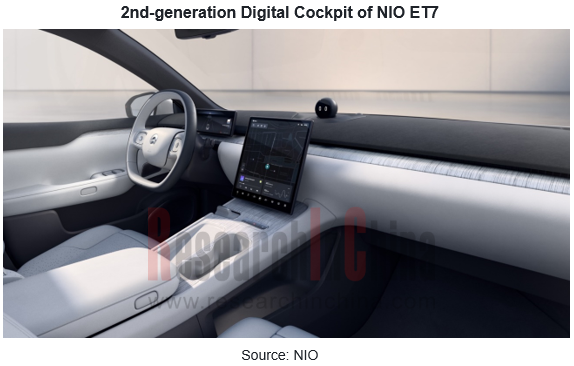
Appearance and interfaces
NIO ET7 bears NIO’s second-generation cockpit DCU. Compared with the first-generation, the SoC chip of the second-generation cockpit DCU is changed from Nvidia Parker to Qualcomm SA8155P. The second-generation cockpit DCU will be applied to all NIO models.
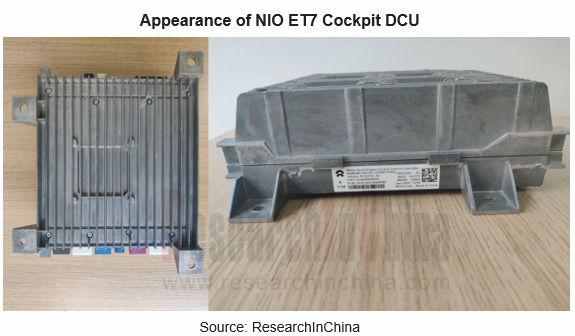
The interfaces on the lower side of the bottom view in the above picture, from left to right, are: center console display and rear display connector, cluster and HUD connector, 1 USB3.0 connector, 2 USB connectors, and 2 Ethernet connectors, and inside the white plastic sleeves are WiFi and Bluetooth antennas.
NIO ET7 cockpit DCU has a distinctive appearance. The heat sink on the backboard is recessed in the middle in a bid to be close to the SA8155P module that generates the most heat.
The interior of the housing of NIO ET7 cockpit DCU is relatively complicated. The inner layer of the housing is also embedded with a spongy material that absorbs impact. The holes on the right correspond to the two large capacitors on the PCB. The two capacitors are relatively high with ultra-large capacity up to 25 farads. They function as a battery. It is presumed that the two capacitors are added in the consideration of the fact that sometimes when a vehicle is parked for too long, the battery runs out of power but some wireless remote vehicle control functions still need to work.
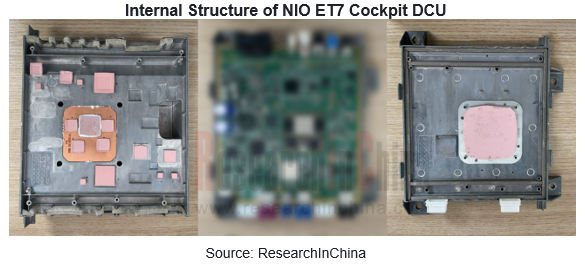
Unlike most vehicle PCBs with connectors on one side, NIO’s cockpit DCU PCB has connectors on both sides.
CPU and memory chip
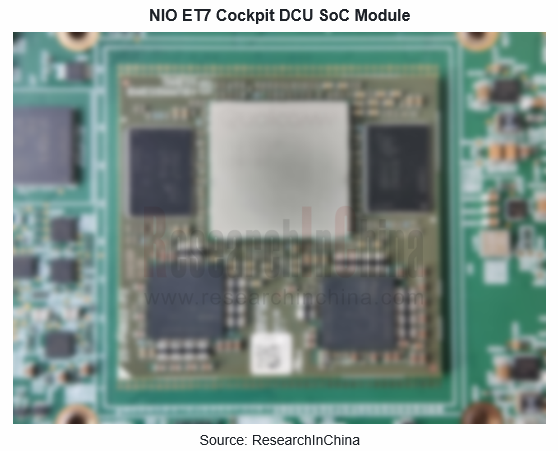
In the center of the DCU PCB lies the SoC module which accommodates one SA8155P chip, two PMM8155AU power management chips and two Micron memory chips.
Next to the capacitor side of the SoC module is a 256GB UFS 2.1 memory chip from Samsung. UFS 2.1 features working voltage of 1.8/3.3V, G3 2Lane interfaces, and temperature range of -40℃~105℃. The estimated price range of this chip is USD15-20.
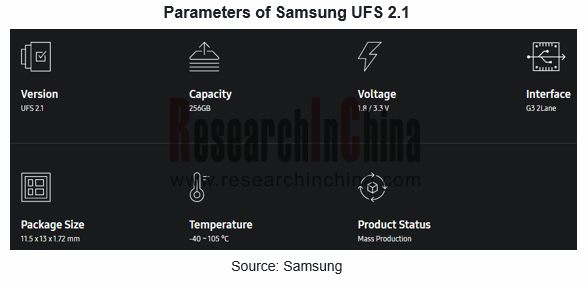
Ethernet switch
The relatively big chip next to the MCU and the capacitor is an 88EA6321 Ethernet switch provided by Marvell.
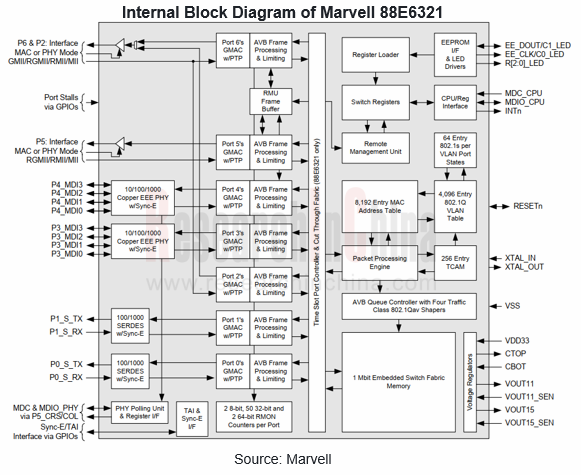
The picture above shows the internal framework of Marvell 88E6321, a 7-port Ethernet switch for automotive EAVB. 88E6321 carries two IEEE 10/100/1000BASE-T/TX/T interfaces (corresponding to RJ45, namely, a conventional registered jack as often said), two RGMII/xMII interfaces or one GMII interface, two SGMII/SerDes interfaces, and one RGMII/xMII interface. The MII (medium-independent interface) is a standard interface connecting the MAC and the PHY. It is an IEEE-802.3 defined Ethernet industry standard.
10/100/1000BASE-T/TX/T refers to the transmission cable. Port 2, 5 and 6 can be configured as MAC or PHY mode, and all support RGMII/RMII/MII. Port 2 and 6 also support GMII. Port 3 and 4 support 10M/100M/1000M adaptive Ethernet interfaces. Port 0 and 1 support 100M/1000M optical ports (SFP). 88E6321 launched around 2014 is an old product that does not support the latest TSN. It is not an automotive Ethernet switch in the strict sense, and is currently sold at a markdown price of about USD10-15. (MII refers to Medium Independent Interface; RMII, Reduced MII; SMII, Serial MII; GMII, Giga MII)
Video I/O
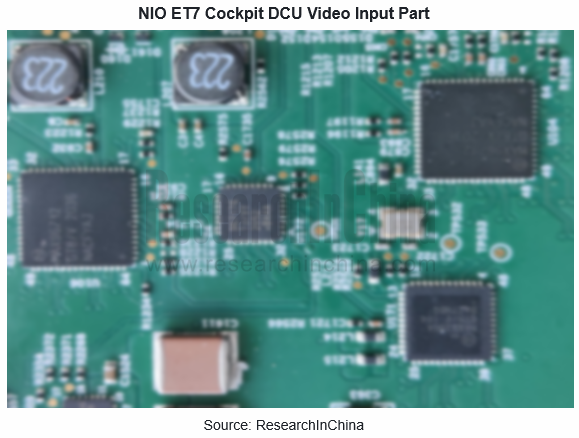
The picture above is the video input part of ET7 cockpit DCU. It uses a total of 4 serializer/deserializer chips (all from MAXIM, a company acquired by ADI), including two MAX96712 deserializer chips, one of which corresponds to the inputs of the four 3-megapixel surround-view cameras of NIO ET7.

The picture above is the internal framework of MAX96712 which enables MIPI CSI-2 4Lane reception and delivers the maximum bandwidth of 6Gbps, that is, it can connect four 4-megapixel cameras and outputs two channels. It is currently the highest bandwidth deserializer chip priced at about USD15-20.
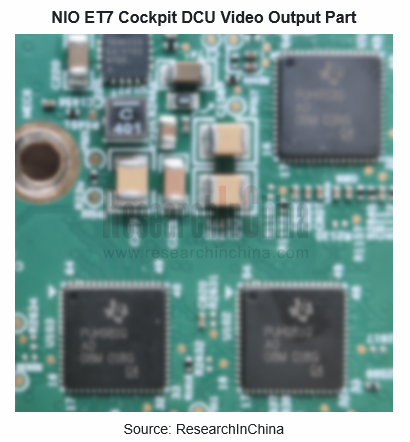
The video output part of NIO’s head unit in the picture above uses three TI serializer chips and video format conversion. All the three serializer chips require signing a non-disclosure agreement (NDA). SA8155 can support a variety of up to 24-megapixel display configuration interfaces (e.g., at most three 4K60 displays) via three native displays. It supports two 4-lane DSI D-PHY at 2.5 Gbps per lane or two 3-trio C-PHY at 5.7 Gbps per lane, an integrated display port shared with USB 3.1 Gen 2 at 8.1 Gbps/lane. It allows for 4K60 display ports concurrency and USB 3.0 operation, and enables other display single interfaces (DDSI) by using DisplayPort multi-stream transport (MST) and dual displays.
Back of PCB
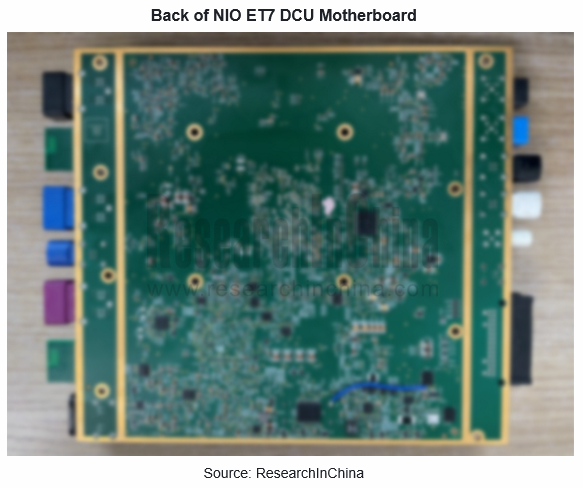
There is a flying line on the front and back of the PCB. The flying line on the back is very obvious, about 4.5cm in length, which means that the PCB needs hand soldering in the end. This will affect efficiency and quality stability, and will also push up the overall cost of the cockpit DCU.
Autonomous Driving Domain Controller and Central Computing Unit (CCU) Industry Report, 2025
Research on Autonomous Driving Domain Controllers: Monthly Penetration Rate Exceeded 30% for the First Time, and 700T+ Ultrahigh-compute Domain Controller Products Are Rapidly Installed in Vehicles
L...
China Automotive Lighting and Ambient Lighting System Research Report, 2025
Automotive Lighting System Research: In 2025H1, Autonomous Driving System (ADS) Marker Lamps Saw an 11-Fold Year-on-Year Growth and the Installation Rate of Automotive LED Lighting Approached 90...
Ecological Domain and Automotive Hardware Expansion Research Report, 2025
ResearchInChina has released the Ecological Domain and Automotive Hardware Expansion Research Report, 2025, which delves into the application of various automotive extended hardware, supplier ecologic...
Automotive Seating Innovation Technology Trend Research Report, 2025
Automotive Seating Research: With Popularization of Comfort Functions, How to Properly "Stack Functions" for Seating?
This report studies the status quo of seating technologies and functions in aspe...
Research Report on Chinese Suppliers’ Overseas Layout of Intelligent Driving, 2025
Research on Overseas Layout of Intelligent Driving: There Are Multiple Challenges in Overseas Layout, and Light-Asset Cooperation with Foreign Suppliers Emerges as the Optimal Solution at Present
20...
High-Voltage Power Supply in New Energy Vehicle (BMS, BDU, Relay, Integrated Battery Box) Research Report, 2025
The high-voltage power supply system is a core component of new energy vehicles. The battery pack serves as the central energy source, with the capacity of power battery affecting the vehicle's range,...
Automotive Radio Frequency System-on-Chip (RF SoC) and Module Research Report, 2025
Automotive RF SoC Research: The Pace of Introducing "Nerve Endings" such as UWB, NTN Satellite Communication, NearLink, and WIFI into Intelligent Vehicles Quickens
RF SoC (Radio Frequency Syst...
Automotive Power Management ICs and Signal Chain Chips Industry Research Report, 2025
Analog chips are used to process continuous analog signals from the natural world, such as light, sound, electricity/magnetism, position/speed/acceleration, and temperature. They are mainly composed o...
Global and China Electronic Rearview Mirror Industry Report, 2025
Based on the installation location, electronic rearview mirrors can be divided into electronic interior rearview mirrors (i.e., streaming media rearview mirrors) and electronic exterior rearview mirro...
Intelligent Cockpit Tier 1 Supplier Research Report, 2025 (Chinese Companies)
Intelligent Cockpit Tier1 Suppliers Research: Emerging AI Cockpit Products Fuel Layout of Full-Scenario Cockpit Ecosystem
This report mainly analyzes the current layout, innovative products, and deve...
Next-generation Central and Zonal Communication Network Topology and Chip Industry Research Report, 2025
The automotive E/E architecture is evolving towards a "central computing + zonal control" architecture, where the central computing platform is responsible for high-computing-power tasks, and zonal co...
Vehicle-road-cloud Integration and C-V2X Industry Research Report, 2025
Vehicle-side C-V2X Application Scenarios: Transition from R16 to R17, Providing a Communication Base for High-level Autonomous Driving, with the C-V2X On-board Explosion Period Approaching
In 2024, t...
Intelligent Cockpit Patent Analysis Report, 2025
Patent Trend: Three Major Directions of Intelligent Cockpits in 2025
This report explores the development trends of cutting-edge intelligent cockpits from the perspective of patents. The research sco...
Smart Car Information Security (Cybersecurity and Data Security) Research Report, 2025
Research on Automotive Information Security: AI Fusion Intelligent Protection and Ecological Collaboration Ensure Cybersecurity and Data Security
At present, what are the security risks faced by inte...
New Energy Vehicle 800-1000V High-Voltage Architecture and Supply Chain Research Report, 2025
Research on 800-1000V Architecture: to be installed in over 7 million vehicles in 2030, marking the arrival of the era of full-domain high voltage and megawatt supercharging.
In 2025, the 800-1000V h...
Foreign Tier 1 ADAS Suppliers Industry Research Report 2025
Research on Overseas Tier 1 ADAS Suppliers: Three Paths for Foreign Enterprises to Transfer to NOA
Foreign Tier 1 ADAS suppliers are obviously lagging behind in the field of NOA.
In 2024, Aptiv (2.6...
VLA Large Model Applications in Automotive and Robotics Research Report, 2025
ResearchInChina releases "VLA Large Model Applications in Automotive and Robotics Research Report, 2025": The report summarizes and analyzes the technical origin, development stages, application cases...
OEMs’ Next-generation In-vehicle Infotainment (IVI) System Trends Report, 2025
ResearchInChina releases the "OEMs’ Next-generation In-vehicle Infotainment (IVI) System Trends Report, 2025", which sorts out iterative development context of mainstream automakers in terms of infota...